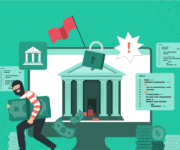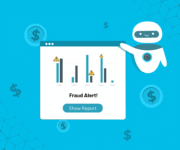The advent of new technologies has paved the way for a new era of financial services within the digital ecosystem. Thanks to the milieu of fintech companies, small to medium-sized businesses can get access to capital resources easily.
However, with new pathways, opportunities are rife for sophisticated fraud strategies, greatly harming the financial services industry. In fact, according to recent findings from our Global Identity and Fraud Report, 55 percent of businesses globally reported an increase in fraud-related losses over the past 12 months
Despite the tightened reins on lending, business loan fraud is still prevalent. Therefore with all the advancements that fintech companies provide, how can they ensure that they are a step ahead of uncovering business loan fraud?
Here are the ways you can detect business loan fraud:
Identifying a Business Loan Fraud
Small business loan frauds are not as visible as consumer loan frauds because businesses are not really viewed as victims in the way consumers are. There is a lack of legislation requiring frauds to be reported and therefore, a dearth of information to identify them.
Besides, the fact that a business loan fraud can be three to ten times more profitable than consumer loans, this should be a growing concern for companies to adopt the right strategy to identify red flags and tackle them effectively.
1. Knowing the Small Business Fraud Types
Business loan frauds can be characterised based on a first-party or third-party basis, varying significantly in frequency, severity and complexity. A first-party fraud or victim-less profile is attributed to having some form of material misrepresentation. For example, misstating revenue figures in the loan application.
The second type is third-party involving a third-party stealing the identification details of a known business or an owner in order to borrow credit using the victim’s name.
2. No Physical Presence of the Business
Businesses that don’t have an official physical presence or are shell companies run by fictitious entities can be a cause of suspicion. These type of businesses are often created for money laundering and are easy to form and operate.
3. Multiple Businesses Associated with One Person
Having multiple businesses under one owner is a red flag that needs more research and exploration to find out if it’s legitimate. Look at how much each business is earning and if there’s not much income to it, it can indicate something suspicious.
4. Commercial Bust Out
A bust-out is another tactic that involves the criminal opening several lines of credit under different business names and eventually abandoning all accounts after maxing out or exceeding all the credit lines.
5. Lack Of A Solid Business Plan
Getting a thorough understanding of what the business is doing and aims to do is of utmost importance. What is the overall business strategy? If the company lacks a lucrative plan, the chances are high that it can be a scam to extract money.
6. Inflated Earnings
Several businesses tend to have overly exaggerated or misrepresented earnings in their book of accounts. Some do it deliberately while others can do it mistakenly without the intent. In either case, if the company’s income appears to be inflated that what it actually should be, it can only be known with proper verification.
7. Unaudited Financials
The financial health of the company should not be taken for granted on the sole basis of the applicant’s words. Always insist on audited financial statements. Since it’s very easy to fabricate the financials, you should always rely on solid data to verify the financial statements with the bank statements.
8. Never Payment
Never pay or never payment occurs when the business opens a new account and never makes a single payment on any debt owed. This translates as a financial loss for lenders to write it off as a credit risk problem. Never-pay losses are on the rise now more than ever and so, organisations must have a way to predict never-pay behaviour and prevent losses.
9. Account Takeover
This is a third-party fraud when an impostor takes over an existing account that is already established by the legitimate business. These kinds of frauds are facilitated through phishing scams and accomplished with the interception of credit cards and statements to take over an account.
Moreover, business identity thefts that utilise the letterheads and contact information of an existing company are also predominant.
10. Lack Of References
It’s important to check for references to any past dealings with banks or organisations. If something is fishy related to the previous history of the business, then more questions need to be asked. Knowing such references will help to decipher the credibility of the business and their position.
Challenges Faced in Identifying Small Business Fraud
Lenders face a plethora of challenges in identifying business loan fraud. The most critical challenge is to make sure that the data sources that are used to check the applicant’s information are reliable. Rather than relying primarily on the applicant’s self-reported data, there should be scope for cross-verification to understand the credibility of the business.
Moreover, as loans are applied for online, using the ‘faceless’ channel of Internet and mobile, there is an even greater chance of business loans frauds and scams. Therefore, organisations might need to implement additional risk mitigation efforts in delivery channels that are not face to face.
Best Practices to Prevent Business Loan Fraud
Incorporating the following measures can reduce the chance of business loan fraud losses:
1. Verify Information from Multiple Sources of Data
A cross-dimensional analysis of several data points including the bank statement, financial statement, GST information, KYC details, credit score, social media channels and more is highly recommended to identify fraudsters.
Conducting a thorough analysis is the best way to eradicate false positives and uncover any anomalies. Using modern technology of big data and machine learning to your advantage will help you decipher customer behaviour and identify any offenders.
2. Smart Decisioning Through Analytics
The prevalent norm across multiple sectors of business is achieving more with fewer resources and balance cost reduction efforts. One common approach to managing customer acquisition costs is through adopting automated decisions through targeted analytics.
Implementing a unique score-based approach that considers the vast data points for the applicant’s creditworthiness assessment will reduce manual efforts and mitigate fraudulent activities. This is where analytics come into play and help you to segregate suspicious entities from those that don’t exhibit characteristics of fraud. As a result, you can oversee trends, patterns and set fraud risk tolerance levels and simplify customer treatment.
Finezza helps to mitigate your risk of business loan frauds by incorporating analytics and a solid credit assessment strategy that will help you get rid of false positives. Finezza’s comprehensive loan management system help clients streamline authentication by verifying and validating business data using analytical tools that account for multiple sources of data from several networks.
We are committed to listening to client needs and producing customised solutions that mitigate business loan fraud by delivering quality data, targeted analytics and blended decision making. A well-executed fraud detecting strategy will improve fraud identification and operational efficiency, in turn reducing customer acquisition costs.
To know more, get in touch with Finezza for a free demo.




Today many frauds are going on in the market and some lenders befool the borrowers throughout different tricks. Thanks for providing amazing information on how this fraud can be prevented. Borrowers before applying for a business loan should research about business loan process and documentation, so that if they feel anything fishy during the process, they can prevent themselves from falling into the trap.